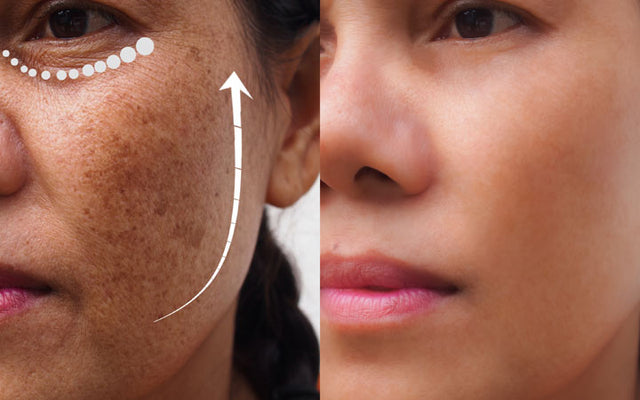Have you been trying to get rid of hyperpigmentation? If yes, you should know about kojic acid, used as a skin-lightening agent in most cosmetics.
Wondering what makes this ingredient so special? Well, from acne scars to dark spots, melasma to sun damage, kojic acid can treat a plethora of your skin issues.
In this article, let's discuss in-depth about kojic acid's usage in skincare, forms, benefits and possible side effects. Scroll down to read more.
Highlights:
What Is Kojic Acid And Is It Safe?
Kojic acid is a natural metabolite produced from different types of fungi. It lightens the skin by preventing the production of tyrosine [1], the amino acid responsible for producing melanin (skin pigment). It also works as an antioxidant in your skincare products.
When examined in acute, chronic and reproductive studies, kojic acid was not found as a toxicant. It gets absorbed into the human skin slowly but does not reach the health risk threshold.
Sources And Forms Of Kojic Acid
Aspergillus oryzae [2] is one of the fungi from which kojic acid is derived. It is also formed during the fermentation of Japanese food products like soy sauce and rice wine.
It is especially used in serums and depigmentation creams. You can also find kojic acid in various forms including powders, cleansers and soap bars.

Benefits Of Kojic Acid
- Melasma treatment: Melasma [3] is a common skin condition that occurs due to hormonal imbalance. It forms dark patches on the skin. Kojic acid helps treat melasma by lightening those pigmented areas.
- Anti-ageing: Kojic acid is a UV protective, known for treating sun damage. This, in turn, reduces your age spots, fine lines and wrinkles, making you look youthful.
- Scar Lightening: Kojic acid can work on the scars of your skin, caused by acne or injuries. However, it would not improve the thickness of your scar tissue.
- Antibacterial benefits: Kojic acid is also enriched with antibacterial properties. It can help you fight against a wide range of common bacterial skin infections. Hence, kojic acid can fade away acne caused by bacteria.
- Antifungal effects: Kojic acid is considered an antifungal element. It is used in many antifungal products to double up their effectiveness. Kojic acid may help you prevent certain fungal infections, like ringworm, yeast infections, candidiasis. You can use kojic acid soap to treat these kinds of fungal infections.
Recommended Dosage Of Kojic Acid
Many studies have been conducted to determine a safe concentration amount for Kojic acid. As per scientific research [4], kojic acid is safe to use within 1-4% concentration in cosmetics.
Two double-blind studies concluded that a combination of 2% kojic acid with 2% hydroquinone and 4% kojic acid with 5% glycolic acid works efficiently on pigmentation.
The combinations showed visible results in 52% cases of pigmentation. However, you should strictly avoid overdosage of kojic acid (beyond 4%) as it may lead to severe skin irritation and sensitivity.
Tips On Using Kojic Acid In Skin Care
As kojic acid comes in many forms like powder, lotions, serum etc, you need to keep in mind the following:
1. For example, while using powders, always mix Kojic acid with water/ lotion and abide by the product instructions.
2. Typically, kojic acid starts showing results within two weeks. If you want to see faster results, you may add glycolic acid to the treatment.
3. When you apply kojic acid creams or serums, give some time for your skin to absorb it completely.
4. For products like kojic acid soap and cleansers, we advise you to rinse it off shortly after application.
5. Use products as instructed. For example, face masks are only meant to be used occasionally. While you can use kojic acid creams every day.
6. Though kojic acid products are mainly used on the face and hands, you can use it on almost any area of your body except eyes, nose, inside your mouth and private parts.
Side Effects And Precautions
Even though kojic acid has been declared a safe ingredient for cosmetic use, few people may face mild side effects. The most common side effect of kojic acid is contact dermatitis [5].
Noticeable symptoms of contact dermatitis are redness, irritation, rashes, swollen skin and discomfort. People with sensitive skin or individuals using kojic acid more than the instructed amount may get contact dermatitis.
If you use kojic acid for a long time, your skin may get sensitive to the sun. It is always recommended to wear sunscreen and protective clothing to avoid sun damage.
To avoid any kind of major side effects, you should take the following precautions while using kojic acid products:
1. Do not apply kojic acid on any broken or damaged skin.
2. If you have allergies or any other skin conditions, consult your doctor before using any product containing kojic acid.
3. Always follow the instructions written on the label when you use kojic acid products.
4. If the product is doctor prescribed, follow your doctor’s direction without fail.
5. In case rashes or irritation occurs after using kojic acid products, discontinue use immediately and talk to your doctor about it.
Wrapping Up
Kojic acid is an expert in treating hyperpigmentation or scarring. But you must not use it just to lighten your pigmented skin. If you are using it for any particular skin conditions, you should consult a dermatologist for the best and safest way to use kojic acid.
If you are looking for a cure for your dark spots, then SkinKraft has the best solution. SkinKraft’s Dark Spot Control Serum With Glow Boosters contains kojic acid, which reduces dark spots while offering you a smooth and radiant glow.
Recommended Products
Was this Article helpful?
- Least helpful
- Most helpful











